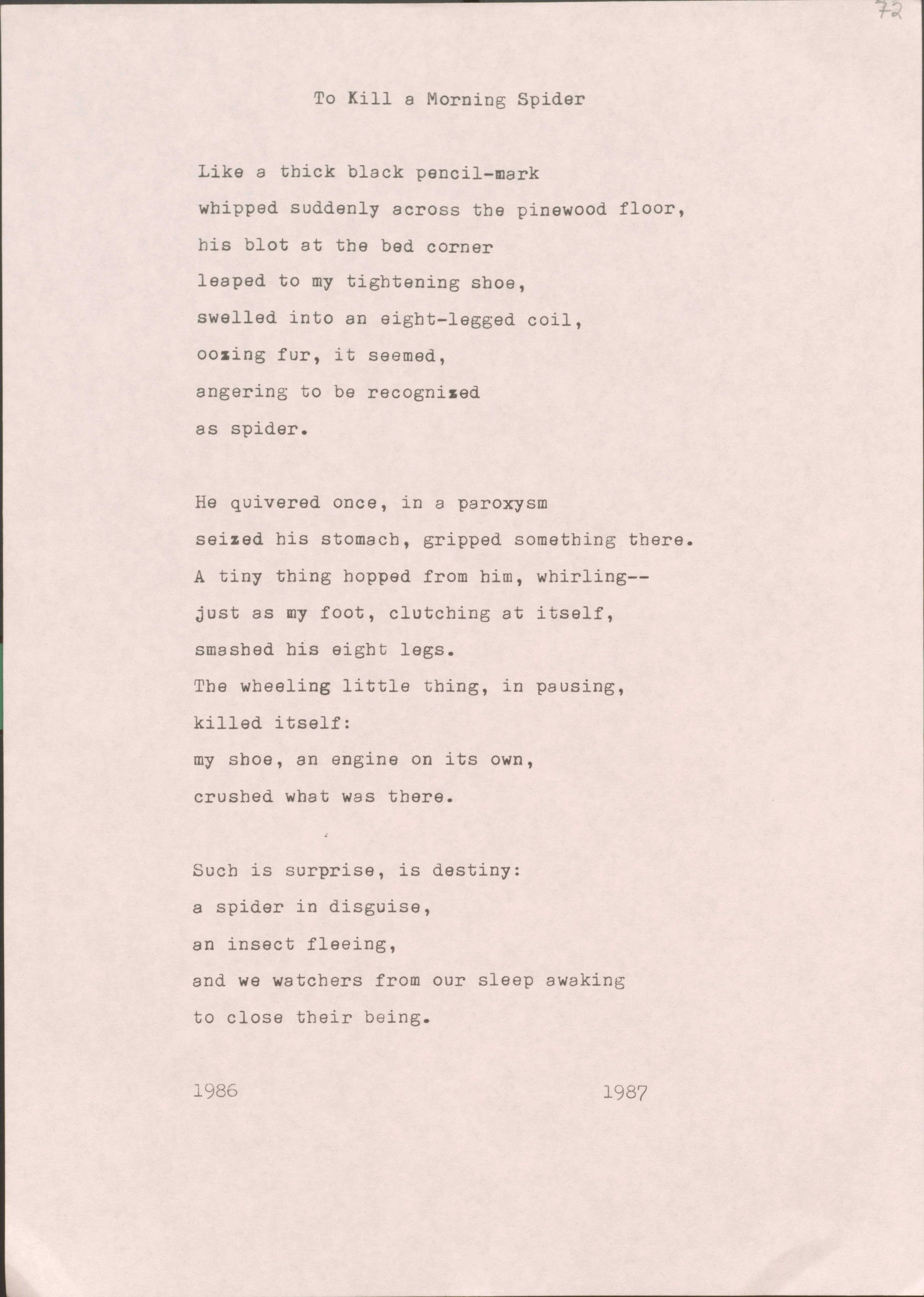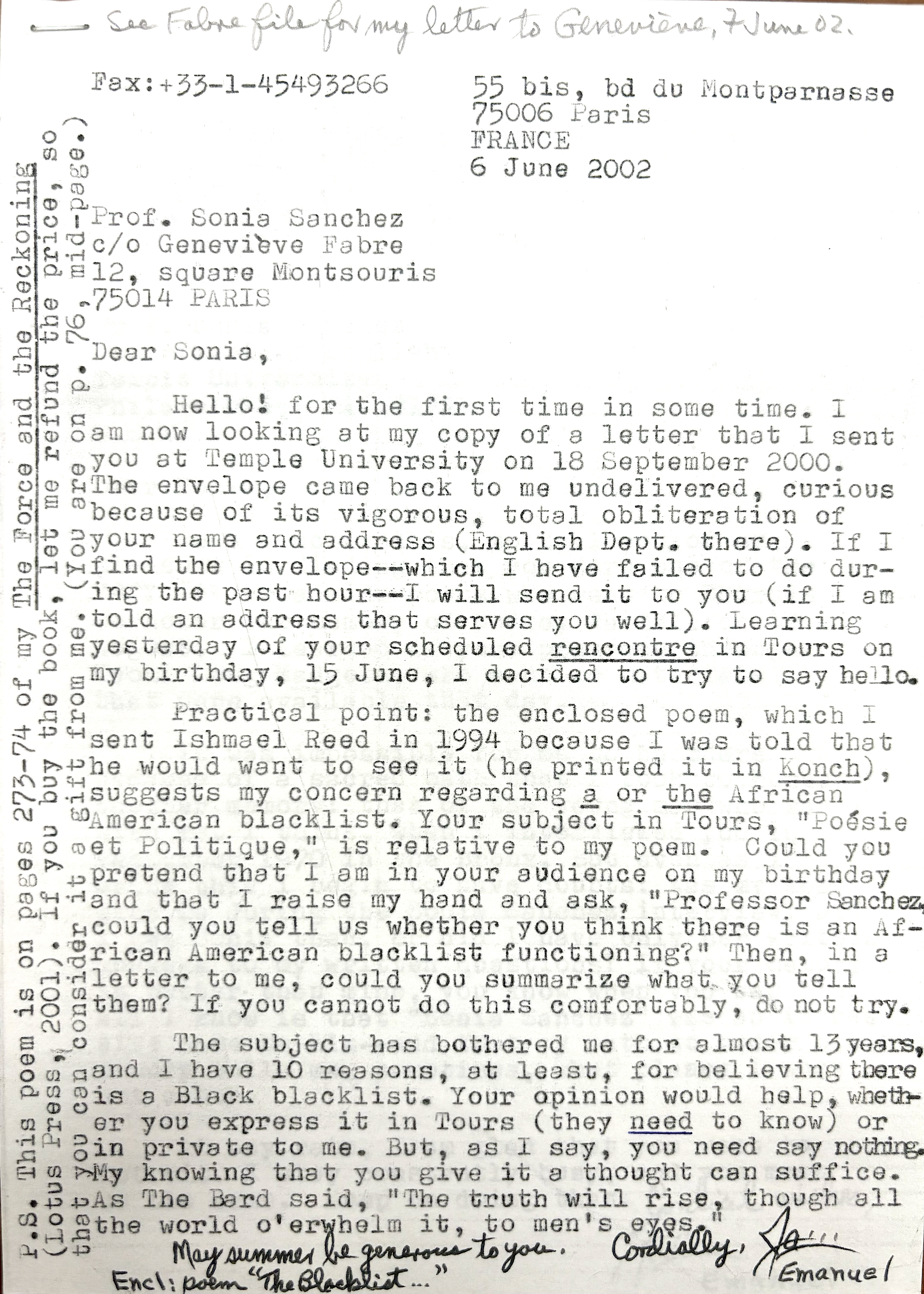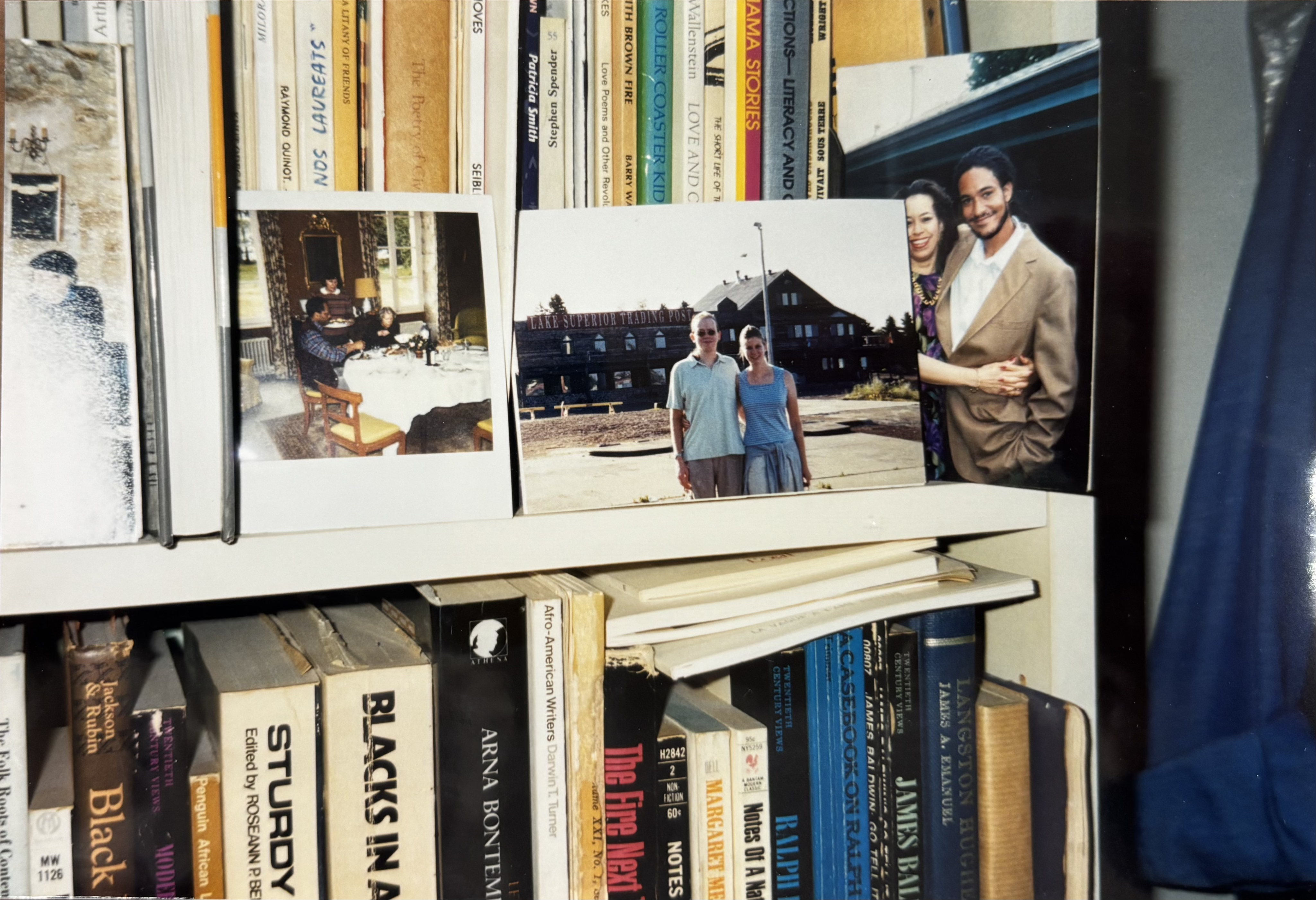Mini Story: Dan Schneider (Cosmoetica)
At one time, if you were to look up James A. Emanuel using a search engine, Daniel Schneider’s Cosmoetica, a website featuring literary criticism and interviews, may have been listed in your top search results. Schneider’s first mention of Emanuel dates back to March 6, 2001, and in that blog post, he writes with authority about Emanuel’s style but with some speculation about Emanuel’s life.
In fact, back in 2001, Schneider, also a poet and writer, could find only one online source mentioning Emanuel; the website featured Emanuel’s poem “The Negro.” But it was nearly a decade prior around 1993 that Schneider came across Emanuel’s poetry while in a used bookstore in St. Louis Park, Minnesota. He felt that he had stumbled upon “the most neglected poet in American poetry” (“The Not So Strange Emanuel Case”). That first blog post on Emanuel is written in part as a call to action to read Emanuel’s work and a defense of Emanuel’s literary merit exemplified by a close reading of Emanuel’s poems “The Negro,” “For a Farmer,” “Sonnet for a Writer,” and “To Kill a Morning Spider.”

Figure 1. Poem written by Emanuel in 1986/1987, typed, describes killing a spider. The poem alludes to "Allowables" by Nikki Giovanni.
Less than two years later, Emanuel’s translator, Jean Migrenne, shared Schneider’s blog post with Emanuel, and Emanuel received this news with much appreciation. In Emanuel’s Christmas Notes of 2002, Schneider is referenced twice. The first reference is to the blog entry, which is labeled as “MY FIRST INTERNET reference.” The second reference is in the category "POEMS ON INTERNET" and mentions Schneider’s reprint and analysis of the poem “For the 4th Grade: Prospect School: How I Became a Poet.” After Emanuel and Schneider made contact, more engagements between the two were to follow. Schneider published an interview with Emanuel, Migrenne and Godelieve Simons, Emanuel’s artistic collaborator; he published a written interview with Emanuel; he uploaded his own recitations of Emanuel’s poetry; and he made available on YouTube the full Middle Passage album. Through their engagements and before this project, Schneider’s online presentation of Emanuel’s life and work was the most comprehensive.
![Christmas 2002 Notes on Literary Happenings of the Year (James A. Emanuel) Dear Friends, l submit this 12th list of Christmas-card padding: Entries known too late for prior lists: Tyler Stovall’s Paris Noir: African Americans in the City of Light 1996) devotes Pages 302-304 to me. 869S 302-304 to me. My review essay ‘On Selected Poems’ is in Robert Hayden: Essay on the Poetry (Ann Arbor: Univ . of Michigan Press , 2001), pp. 63-64. Revlew of JAZZ from the Haiku King in American Book Review, July-August 2000, by John Frazier. Review of the same book in Black Issues Book Review, March – April 2001, p. 38, by Brian Gilmore. My FIRST INTERNET reference: Dan Schneider’s essay ‘The Not So Strange Emanuel Case,’ 6pp. on cosmoetica@att.nett. (6 March 2001), begins ‘In the annals of American poetry it is difficult to conceive of a more neglected great poet than James A. Emanuel.’ POETRY READINGS: 2002 only 19 Feb: The Live Poets Society, Flann O’Brien’s Irish Pub, Paris, JAE with Jacques Rancourt and Sean Street. Several listeners told the organizer John Kliphan ‘how much they were moved’ by JAE (say the letter). 8 March: The Red Wheelbarrow, Paris. With Barry Wallenstein & John Kliphan. 9 March: Le Chat Noir, Paris. With Barry Wallenstein + Soisik Libert; Chansse Evans on saxophone, Jeff Catoire contrabass. 24 June: JAE’s apt., Paris. Syracuse Univ. (New York) seminar ‘Paris Noir: Literature, Culture, and Contemporary Life’ led by Prof. Janis Mayes. With Godelieve Simons demonstrating, vis visual art & discussion, how she joins her engravings, etc. and my poetry. (See Art Exhibitions below.) POEMS ON INTERNET: ‘For the 4th Grade, Prospect School: How I Became a Poet.’ Rptd & ana-lyzed, pp, 6-8 of Dan Schneider’s essay Masculine Rites of Passage: 6 Great American Poems, http://www.cosmoetica.com./S*-DES6.htm (31 May) ‘Eleven Poems by [JAE] from his JAZZ from the Haiku King, with Translations by Jean Migrenne’ (these 11-poem groups accessible on http://www.plagiarist.com/features/emanuel/whole_grain.php and http://www.plagiarist.com/features/emanuel/jazz.php (both 19 Jue) ‘The Negro,’ ‘For a Farmer,’ ‘Sonnet for a Writer,’ and ‘To Kill a Morning Spider’ rptd & anlyzed in essay ‘The Not So Strangle Emanuel Case.’ POEMS IN BOOKS: The Norton Introduction to Literature. 8th Ed. Beaty, Booth, Hunter and Mays (New York: W.W. Norton). ‘Jazznatomy,’ p. 1009; ‘Ray Charles,’ 1144; ‘Emmett Till,’ 1166-67; blog., A.75. Probably the first printing by a major academic anthology of jazz-haiku, a form I created in 1992. Poetry in Performance 30, Anniv. Edn., Spring Poetry Festival of CCNY (New York: The Print Center). ‘Women Laughing,’ p. 163. ESSAY BY JAE: ‘Crossing the Musical Bridge: a Poet’s Collaborations with Musicians,’ in Anglophonia: French Journal of English Studies 11, pp. 195-97. BOOK REVIEWS (OF JAE’S WORKS): Hakutani, Yoshinobu, re JAZZ from the Haiku King, in African American Review, Vol. 35, No. 4 (Winter 2001) (rec’d Apr. 2002), pp. 681-84. Chevalier, Victoria., re The Force and the Reckoning in American Book Review, Vol. 23, No. 2 (Jan./Feb. 2002), p. 29. INTERVIEWS OF JAE (WITH VIDEO): 11 March: by Julian Johnson (2 hours) 11 July: by Lester Sloan & daughter Aisha (3 hours) ART EXHIBITS SHOWING JAE POEMS & BOOKS: 8-21 April: 11eme Biennale Internationale de Gravure en Val d’Oise at Theatre Pierre Fresnay in Ermont, France. 2 haiku of series of 7 in Godelieve Simons’ Les nuits de la pleine lune. 24 July: Cite Universitaire, Maison des Etudiants Armeniens, Paris. Poetry reading & discussion (with Hunter College students from the City Univ. of New York and their Prof. Janet Hulstrand), with Godelieve Simons showing and discussing her works of art and how they use JAE literary works. Art + poetry examples: ‘pleine lune’ & ‘Smooth stone’ & Rhythm in Black and White haiku; JAZZ FORCE & CD cover art.](https://cuny.manifoldapp.org/system/resource/a/b/9/ab977b14-ef55-435d-975b-cbc332821fe8/attachment/45bd959fac34254662da8148826298d0.jpg)
Figure 2. James Emanuel's 2002 annual "Notes on Literary Happenings of the Year." He included these "Notes" of his literary engagements in his Christmas Cards between 1990 and 2006.
Emanuel and Schneider sought to increase access and circulation of Emanuel’s works. They both felt that his work was not receiving the attention it deserved. In fact, Emanuel writes in his autobiography The Force and the Reckoning (2001) that it bothered him that he was not included in the first Norton Anthology of African American Literature that was published in 1996. It was shortly after his initial engagement with Schneider that Emanuel wrote a letter to Sonia Sanchez, who did not respond because she was no longer at Temple University, asking, as if he was a student in her class, “could you tell us whether you think there is an African American blacklist functioning?” The timing of Emanuel’s letter to Sanchez suggests that his conversations with Schneider may have fanned his inquiry.

Figure 3. Typed letter to Sonia Sanchez from James Emanuel, dated June 6, 2002. Document features handwritten annotations He asks Sanchez about the alleged African American literary blacklist.
Schneider’s promotion of Emanuel’s poetry online for over twenty years demonstrates the value he places on Emanuel's work and his dedication to providing access to it. Schneider’s efforts also provide insights about how Emanuel's career based in France (distant from his primarily English reading audiences) may have been impacted by the digital divide. Though Emanuel left the U.S. for France during a time when physical proximity offered far greater visibility than the developing digital realm (1984), overtime his limited circulation in the digital spaces may have impacted his exposure to new audiences. Having a website like Cosmoetica was important to creating consistent digital connection to his work.
While Emanuel and Schneider never bridged their physical distance to meet in person, and their phone conversations perhaps only totaled seven hours, their friendship lasted until Emanuel’s death in 2013. Despite their distance and the technical challenges, the men were important to each other. At his home in Paris, Emanuel took a photo of a part of his bookshelf. On it were three photographs of people significant to him: (1) Madame Plassard, the mother of Marie-France Plassard, who for years welcomed Emanuel to live and write at her home in Condom, France; (2) Daniel Schneider and his wife Jessica, and (3) Emanuel’s beloved niece Cheri Emmons and great-nephew Raymond Smith.

Figure 4. James A. Emanuel’s description of a photograph (punctuation follows the original): Photos of my bookshelf at 55, bis: (1) Mme. Plassard and I at the table at Le Barry, served by Marie-France, (2) Daniel + Jessica Schneider, who discovered my poetry in 2001 and wrote (Daniel wrote) the Internet essay "The Not too Strange Emanuel Case" in 2001; (3) my niece in Denver, Cheri Emmons, with Raymond Smith, son of my nephew: James Wade Smith + wife Josephine, all in Denver, CO. JAE, Paris, 25.04.2007.
Figure 5. Oral History Interview with Daniel Schneider.
Works Cited
Schneider, Dan. "The Not So Strange Emanuel Case." Cosmoetica, 6 Mar. 2001, http://www.cosmoetica.com/s1-des1.htm. Accessed 29 Apr. 2025.